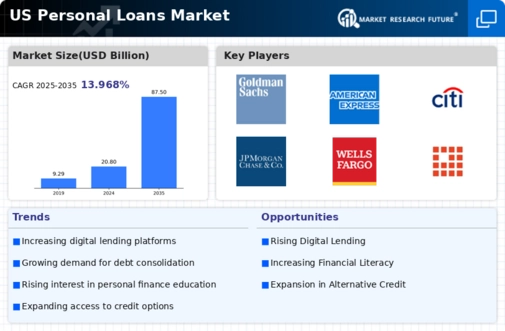Rising Consumer Debt Levels
The personal loans market is significantly influenced by rising consumer debt levels in the United States. As of 2025, total consumer debt has surpassed $16 trillion, with personal loans accounting for a substantial portion of this figure. This increase in debt levels often compels consumers to seek personal loans for debt consolidation, home improvements, or unexpected expenses. The growing reliance on personal loans indicates a shift in consumer behavior, where individuals are more willing to leverage credit to manage their financial obligations. Consequently, this trend may drive growth in the personal loans market as lenders respond to the increasing demand for accessible credit solutions.
Evolving Consumer Preferences
Consumer preferences are evolving, leading to a notable impact on the personal loans market. Today's borrowers are increasingly seeking flexible loan options that cater to their specific needs, such as lower interest rates, customizable repayment terms, and faster approval processes. This shift in preferences is prompting lenders to innovate their offerings, creating a competitive landscape within the personal loans market. As of 2025, surveys indicate that nearly 70% of consumers prioritize convenience and speed when applying for loans, suggesting that lenders must adapt to these expectations to remain relevant. This evolution in consumer behavior is likely to shape the future of lending practices.
Increased Competition Among Lenders
The personal loans market is witnessing increased competition among lenders, which is reshaping the landscape of borrowing. With the entry of new fintech companies and traditional banks expanding their digital offerings, consumers now have a wider array of choices. This competitive environment is driving lenders to enhance their services, offering more attractive interest rates and improved customer experiences. As of 2025, it is estimated that the number of personal loan providers has increased by 25% over the past three years. This surge in competition not only benefits consumers through better loan terms but also compels lenders to innovate and differentiate themselves in the personal loans market.
Technological Advancements in Lending
The personal loans market is experiencing a transformation due to rapid technological advancements. Innovations such as artificial intelligence and machine learning are streamlining the loan application process, enhancing credit scoring models, and improving risk assessment. These technologies enable lenders to offer personalized loan products, which can lead to increased customer satisfaction. In 2025, it is estimated that approximately 60% of personal loans will be processed through digital platforms, reflecting a shift towards more efficient lending practices. This trend not only benefits consumers by providing quicker access to funds but also allows lenders to reduce operational costs, thereby potentially increasing profitability in the personal loans market.
Economic Conditions and Employment Rates
The personal loans market is closely tied to economic conditions and employment rates. As of November 2025, the unemployment rate in the United States stands at approximately 4.2%, which is relatively low compared to historical averages. This favorable employment landscape contributes to consumer confidence, encouraging individuals to take out personal loans for various purposes, including major purchases and investments. Furthermore, a stable economy typically leads to increased disposable income, allowing borrowers to manage loan repayments more effectively. Thus, the interplay between economic stability and the personal loans market is crucial, as it influences both demand and lending practices.


















Leave a Comment